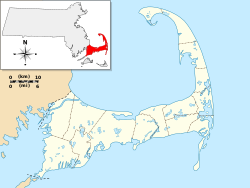Marconi Wireless Station Site (South Wellfleet, Massachusetts)
Marconi Wireless Station Site | |
 Interpretive display pavilion at the site, April 2010 | |
| Location | South Wellfleet, Massachusetts |
|---|---|
| Coordinates | 41°54′50″N 69°58′16″W / 41.91389°N 69.97111°W |
| Built | 1901 |
| Architect | Carl Taylor |
| NRHP reference No. | 75000158[1] |
| Added to NRHP | May 2, 1975 |
The Marconi Wireless Station Site in South Wellfleet, Massachusetts, USA is the site of the first transatlantic wireless communication between the United States of America and Europe, on January 18, 1903.[2] At this location, now part of the Cape Cod National Seashore (though no admission is charged if not visiting Marconi Beach), inventor Guglielmo Marconi erected a large antenna array on four 210-foot (64 m) wooden towers, and established a transmitting station powered by kerosene engines that produced the 25,000 volts of electricity needed to send signals to a similar station in Poldhu, Cornwall, United Kingdom. The first transmission received on the continent of North America by Marconi was at Signal Hill, St. John's, Newfoundland and Labrador in 1901; Glace Bay, Nova Scotia was the site of the first such two-way transmission, in 1902.[2]
One of the station's most notable roles occurred with the sinking of the RMS Titanic in April 1912. Operators at the station were able to alert the RMS Carpathia so that the rescue of some of the Titanic's passengers could be effected.[2] The station was shut down in 1917 in part over concerns about its use in World War I, but also because its towers were threatened with erosion. In 1920, usable materials and equipment were removed from the site, and it was abandoned. Erosion has taken its toll over the years since then,[3] and there was little left as of the date of the National Park Service brochure.[2] No trace of the site remains as of September 2014; the sea has claimed it all.[citation needed]

The site was listed on the National Register of Historic Places in 1975.[1]
See also
[edit]- WCC (radio station)
- Marconi station (general list)
- National Register of Historic Places listings in Cape Cod National Seashore
- National Register of Historic Places listings in Barnstable County, Massachusetts
References
[edit]- ^ a b "National Register Information System". National Register of Historic Places. National Park Service. April 15, 2008.
- ^ a b c d "Marconi and the South Wellfleet Wireless". National Park Service. Retrieved 2023-02-16.
- ^ "Dune Erosion Forces Demolition Of Marconi Interpretive Kiosk At Cape Cod National Seashore". National Parks Traveler. 2013-07-24. Retrieved 2016-06-29.
While some artifacts from the original station site remain, most have been lost over time as the shoreline has eroded. Continued shoreline erosion prompted the decision to raze the kiosk, which stood just 32 feet from the edge of the cliff when it was demolished on Tuesday.
- 1901 establishments in Massachusetts
- Buildings and structures in Barnstable County, Massachusetts
- Former broadcast transmitters
- Industrial buildings and structures on the National Register of Historic Places in Massachusetts
- Infrastructure completed in 1901
- National Register of Historic Places in Cape Cod National Seashore
- Telecommunications buildings on the National Register of Historic Places
- Wellfleet, Massachusetts
- Barnstable County, Massachusetts Registered Historic Place stubs




